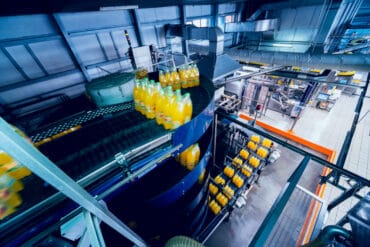
Smart manufacturing based on edge solutions delivers real-time insights that can improve operations and provide global visibility into progress towards desired business outcomes.
Smart manufacturing, rooted in data-driven real-time decisions, has the potential to improve operational efficiencies, product quality, and even customer service. It aims to do that by leveraging vast amounts of edge data. Benefits abound when that data is available to all groups in an organization. Unfortunately, many companies face obstacles on their path to smart manufacturing.
RTInsights recently sat down with Varun Taware, Consultant, Edge Product Marketing, at Dell Technologies, to discuss the importance of having edge data widely available, the issues most companies face when undertaking smart manufacturing edge efforts, and how Dell Technologies can help. Here is a summary of our conversation.
RTInsights: What’s the value in having manufacturing edge data available to all groups, such as IT and OT?

Taware: The value of the edge data is to gain insights that facilitate real-time decision-making. Manufacturers today are driven by business outcomes. They are investing in what they call continuous process improvement in pursuit of driving operational excellence. They need data-driven insights to achieve business outcomes around operational optimization, improving their OEE KPI, improving the production quality, and more. And this all stems from the growing influence of Industry 4.0 paradigms that make smart manufacturing the new frontier for competition and growth.
And for this, manufacturing enterprises must make quick decisions in real-time to protect the integrity of their operations, as well as to protect their P&Ls. So, the data-driven insights from the edge hold the key to this digital transformation that the manufacturers are striving for now.
When you make manufacturing edge data available to all the groups across the operation hierarchy, you can unify the OT, IT, and the business to come together and focus on the business outcomes that are earmarked to be important to the enterprise.
![[Sponsored] There's a simpler path to smart manufacturing outcomes. Learn More](https://no-cache.hubspot.com/cta/default/8019034/211c51e3-267b-4750-a613-16f3a50c7efa.png)
The insights that are built on this manufacturing edge data provide that global visibility of how the enterprise is progressing toward its desired outcome goals. These insights are built-in real-time to help them with better decisions across the organization to impact their KPIs.
Specifically, these rich insights from the edge can help the entire operation’s hierarchy identify, prioritize, and solve the biggest issues that constrain productivity on the factory floor. That is the real value of having this manufacturing edge data made available to all the groups as a single source of truth to facilitate actionable insights.
RTInsights: What are some of the common obstacles manufacturers encounter when trying to tie together their edge and enterprise systems?
Taware: I think of these challenges in four parts: manageability, repeatability, security, and scalability. Let’s look at each of them.
When I talk about manageability, I’m talking about managing the IT, the infrastructure, as well as the data. Elt’s talk about data first. For decades, manufacturers have been putting in varied devices at different locations on the factory floor, chasing a specific use case. Now, with the growth of IoT, this practice is growing exponentially.
The growth of industrial IoT, sensors, smart meters, and all these other edge data points has created a data deluge for the manufacturer. They have a lot of streaming data with different kinds of data velocities, volumes, structures, formats, and protocols that are peculiar to each of those disparate data sources. To be able to collect this data, manage, clean it, augment it, and store it in a scalable way is a huge challenge. That could become the sole project for many individuals and companies.
Further, let’s not forget the point of having data is to build insights. But people get stuck simply trying to wrap their hands around managing the data. And they then end up not progressing as much as they would like to in terms of building the insights out of this data. That’s why streamlining the manageability of data is important.
The second aspect of manageability is managing the IT across multiple environments. So, typically what happens is there’s a specific use case or an application that has been identified by a factory. And they decide what applications to get and what devices they might need. They hook it up, build it, and create a data stream. Somebody else, some other team focused on another business use case, uses another application. And so on and so forth. Now, this starts creating these mini technology silos. And that IT environment, in a single factory, could be a combination of multiple mini-technologies packs.
Now, compound that problem with similar variability in the IT environments across different factory sites. Managing this IT across multiple environments is huge. As the edge expands, it becomes more difficult to manage these diverse environments. It is especially a problem in far edge environments where there is no IT presence on the factory floor. No one is able to troubleshoot any issues or deploy and onboard new devices. It’s expensive to start doing that in a traditional IT management model.
Next, there is the issue of repeatability. I touched on this when I mentioned how different mini-technology stacks are created based on use case-driven initiatives. This creates a sprawl of mini-technology stacks, which gives rise to what we call an accidental architecture. It wasn’t an architecture of different technology pieces, hardware, software, and applications that was planned. It just evolved in silos over the course of time, based on piecemeal initiatives.
Now, these solutions work great for those specific use cases and applications, but they cannot be replicated across factory sites due to the varying nature of the different factory environments and the kind of equipment and data sources that are available at different factory sites. These solutions are not scalable. The proliferation of edge devices has covered the factory floor space and conflated the technology architecture adversely. This sprawl limits the ability to apply a unified strategy when it comes to building or driving a scalable, smart manufacturing initiative.
![[Sponsored] There's a simpler path to smart manufacturing outcomes. Learn More](https://no-cache.hubspot.com/cta/default/8019034/211c51e3-267b-4750-a613-16f3a50c7efa.png)
The third issue is security. We have spoken to hundreds of customers across different verticals, including manufacturing, retail, and more. The topmost challenge that has been cited is security. Every edge endpoint that’s added to the infrastructure increases the threat of attack to the security perimeter, as well as the potential for data loss to hackers.
Security risks impede the adoption of new edge applications. The OT leaders, or the operational technology leaders, are always wary of these new technologies owing to security concerns. They are concerned about how they could inadvertently disrupt their operations in an unexpected way. So, that’s why edge technologies deployed on operation floors need to be secure and reliable. The OT, as well as the IT teams, need to have that confidence in the entire technology stack that they are standing up for the edge application.
The last issue I want to talk about is scalability. Many companies do pilots that have a limited scope, and things work great. Once a pilot is successful, the challenge is how to scale it out while retaining that real-time performance. Smart manufacturing pushes that computing workload from the cloud to the edge.
The legacy systems on the manufacturing floor are sometimes 15 to 20 or 25 years old. These are not systems that get refreshed or changed as often as you switch out your laptops, probably, these days. It is often cost-prohibitive to take an approach that thinks about ripping and replacing what you’ve got. However, the limited compute storage and analytical capabilities of these legacy systems can’t deliver the real-time performance demanded by edge applications.
You need to be able to wrap around the legacy systems and expand from there instead of trying to rip and replace them. You have to do this in such a way that scalability for real-time performance is the key in terms of realizing edge benefits.
RTInsights: What are some examples of what can be achieved once these issues are addressed and the obstacles are removed?
Taware: When you remove the obstacles, you enable your organization to adopt edge applications that closely tie to the business outcomes that you have prioritized for your enterprise.
A recent study by McKinsey shows that half of the manufacturing opportunity for improvement is based on optimizing operations. These improvements equal to billions of dollars across the industry.
To achieve such benefits, you have to overcome obstacles around the complexity of data management, security, scalability for real-time performance, controlling the sprawl, and making your pilots more expandable and repeatable in terms of deployment across factory sites. If you have a handle on these things, you will be able to have successful closed-loop monitoring of your operational initiatives to optimize and improve productivity.
Typically, they say a 5% to 20% improvement is achievable if you have a robust optimization strategy and the supporting IT systems to back the strategy. Let’s take a modest goal of 10% improvement in productivity using the real-time edge insights.
In a typical 80-hour weekly factory production schedule, that would equate to eight hours of unlocked production hours every week. If those eight hours are used for producing additional units, that could generate hundreds of millions of dollars in top-line revenue simply by dedicating those hours back onto the production floor to drive more output.
![[Sponsored] There's a simpler path to smart manufacturing outcomes. Learn More](https://no-cache.hubspot.com/cta/default/8019034/211c51e3-267b-4750-a613-16f3a50c7efa.png)
Alternatively, what if those optimizations come from saving some production hours and overtime hours? If you assume a $30 per hour labor rate, it could save cost in tens of millions of dollars for an enterprise of 50 plants. Or, if you reinvest those saved production hours in some change or initiatives, it could dramatically lower the amount of inventory or the working capital that is required to be maintained by the manufacturer. That itself eases a lot of cash flow pains for the manufacturers. You could elevate the customer service. You could direct those production hours to expand the product mix that you are putting out in your regular production schedule.
So even a modest 10% productivity improvement can have a significant impact on the bottom line of a manufacturing enterprise. So, if you can overcome the edge obstacles, you will have success in deploying these edge solutions that can drive those real-time insights that help you make those decisions impacting your KPI.
RTInsights: How does Dell Technologies help?
Taware: Dell Technologies has been supporting edge initiatives for a long time. We have an extensive and broad portfolio of products that address a lot of these edge applications and use cases. And customers have been using these products in their use case-driven initiatives.
We continue to build end-to-end validated edge solutions with an ecosystem of partners that bring targeted applications that support the different edge needs of manufacturers.
We are building this portfolio. We have launched a couple of end-to-end validated designs for manufacturing edge, partnering with companies like PTC and Litmus. With these validated designs, we have taken the guesswork out of the equation for our customers. These solutions are tested and validated by our engineers and sized appropriately based on the factory workload.
Our solution with Litmus enables centralized management and orchestration of devices while enabling the consumption of AI and machine learning models at the edge. It does this in a way so that the historical data has been put to use to identify atypical patterns that point to certain issues or disruptions that could happen. With this, we are able to help the customer see those red flags before those systems actually come down.
Just recently, we announced an enhancement to our validated design with PTC to support their digital performance management solution. The digital performance management solution provides the closed-loop insights to help the customer and manufacturers identify, prioritize, and dig deeper into the root causes of different issues that are impacting the productivity on the factory floors. It helps them prioritize issues or recommend actions to address those problems and get those production hours back onto the production floor.
This validated design will be the first enterprise-level deployment of PTC’s digital performance management solution. This solution comes pre-loaded with six different dashboards that are geared towards specific analysis, including bottleneck analysis and understanding action trackers to track the progress of different actions that have been taken for me to get the potential issues that have been highlighted.
So, instead of telling the production managers, hey, here are the ten different things that are going wrong on the production floor, it goes a step beyond that and helps identify the top one or two things that they need to prioritize to get the biggest bang for their buck.
That helps manufacturers direct their limited bandwidth and resources to address the problems that matter the most. We are building these validated designs with several partners. I just spoke about the two partners, Litmus and PTC. But we are in a roadmap year, and we still have a lot of partners that we are working on to support applications in areas such as using computer vision for production quality and more.
RTInsights: Could you give us some examples of how Dell’s edge solutions have worked for enterprises?
Taware: Dell has been helping enterprises across industries to be successful at the edge. Let me share a few examples. Recently, we helped McLaren stand up a modern edge that process 100,000 data points per second from 300 sensors on a single Formula 1 car. They were able to build real-time insights data from their edge (the Formula 1 car) to make split-second decisions to improve competitiveness during races. The edge also armed engineers and the trackside team with data-driven insights to enable immediate responses to issues of concern.
Similarly, we have helped DuosTech with an edge solution that combined AI capabilities with computer vision technologies to expedite visual inspection of trains from hours to under 8-minutes.
My favorite edge success story at Dell is with Sentara healthcare. Dell helped Sentara Healthcare to modernize and extend their current infrastructure to the edge to enable the solutions that shave critical seconds off response times to save lives and protect health. The modern edge compute stack from Dell helped them get sub-millisecond response times to save critical time in emergency situations like strokes. Several routine jobs that took 15 hours or more could now be done in just 2hrs. They were also able to save millions of dollars through IT efficiencies and reduced support calls using the modern edge stack from Dell Technologies.
![[Sponsored] There's a simpler path to smart manufacturing outcomes. Learn More](https://no-cache.hubspot.com/cta/default/8019034/211c51e3-267b-4750-a613-16f3a50c7efa.png)







